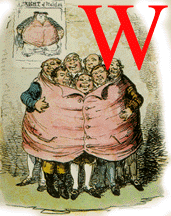[Trollope here sounds much like John Ruskin, who decried the ugliness of what Victorian men wore in the fourth volume of Modern Painters when he argued that “the title 'Dark Ages,' given to the mediaeval centuries, is, respecting art, wholly inapplicable. They were, on the contrary, the bright ages; ours are the dark ones. . . . We build brown brick walls, and wear brown coats.... There is, however, also some cause for the change in our own tempers. On the whole, these are much sadder ages than the early ones; not sadder in a noble and deep way, but in a dim wearied way, — the way of ennui, and jaded intellect, and uncomfortableness of soul and body” (6.321). — George P. Landow]

e have come to be so dingy,—in our taste I was going to say, but it is rather in our want of taste,—so careless of any of the laws of beauty in the folds and lines and hues of our dress, so opposed to grace in the arrangement of our persons, that it is not permitted to the ordinary English gentleman to be anything else but ugly. Chimney-pot hats, swallow-tailed coats, and pantaloons that fit nothing, came creeping in upon us, one after the other, while the Georges reigned—creeping in upon us with such pictures as we painted under the reign of West, and such houses as we built under the reign of Nash, till the English eye required to rest on that which was constrained, dull, and graceless. For the last two score of years it has come to this, that if a man go in handsome attire he is a popinjay and a vain fool; and as it is better to be ugly than to be accounted vain I would not counsel a young friend to leave the beaten track on the strength of his own judgment. But not the less is the beaten track to be condemned, and abandoned, and abolished, if such be in any way possible. Beauty is good in all things; and I cannot but think that those old Venetian senators, and Florentine men of Council, owed somewhat of their country's pride and power to the manner in which they clipped their beards and wore their flowing garments. [Chapter XXIII, “Before Breakfast at Hap House,” Castle Richmond
Bibliography
Trollope, Anthony. Castle Richmond. London & New York: 1906. Project Gutenberg. E-text prepared by Charles Aldarondo, Charles Franks, and revised by Rita Bailey and Joseph E. Loewenstein, M.D.. 5 August 2013.
Last modified 11 August 2013